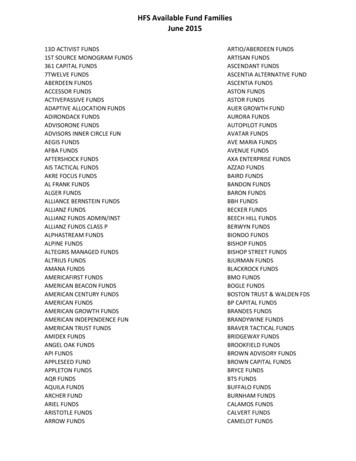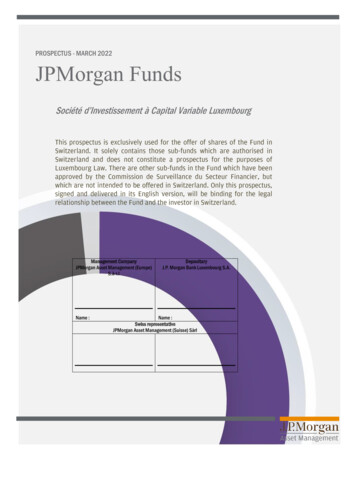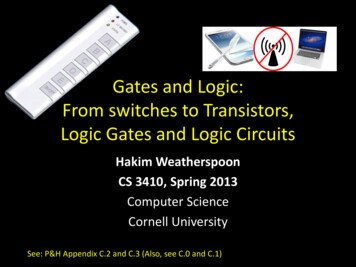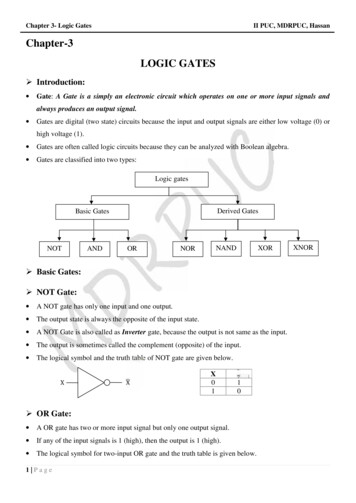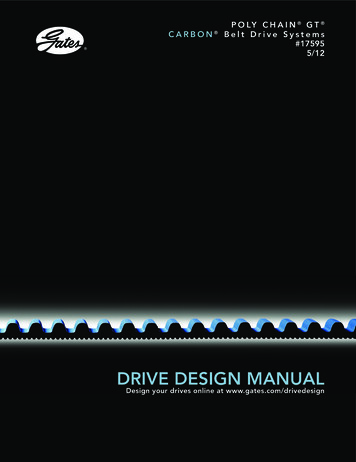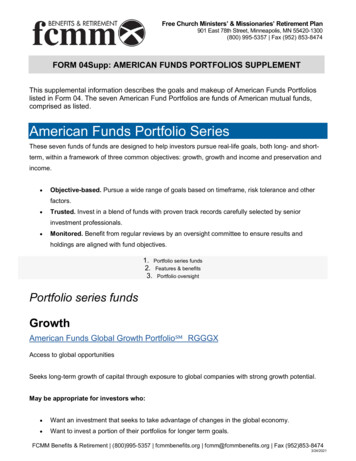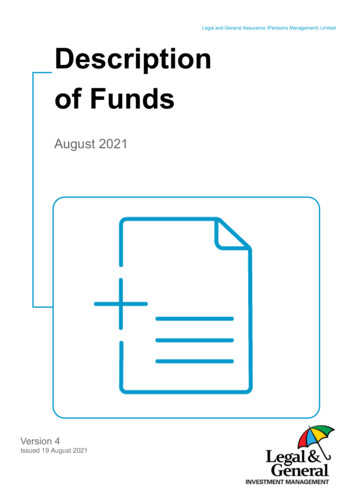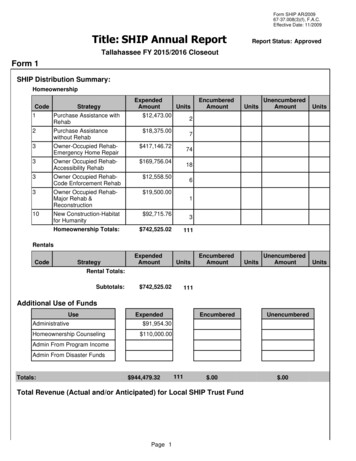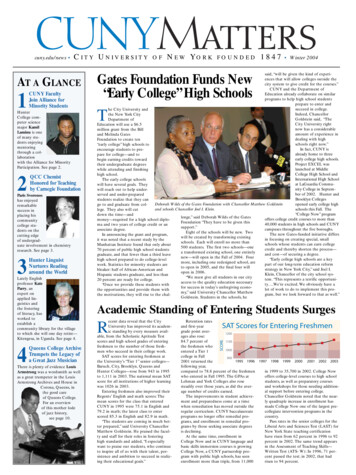
Transcription
cuny.edu/news CITY UNIVERSITYAT A GLANCE1CUNY FacultyJoin Alliance forMinority Students2QCC ChemistHonored for Teachingby Carnegie Foundation3Hunter LinguistNurtures Readingaround the WorldHunterCollege computer sciencemajor KamilLaminu is oneof many students enjoyingmentoringthrough a collaborationwith the Alliance for MinorityParticipation. See page 2.Paris Svoronoshas enjoyedremarkablesuccess inplacing hiscommunitycollege students on thecutting edgeof undergraduate involvement in chemistryresearch. See page 3.Lately Englishprofessor KateParry, anexpert onapplied linguistics andthe fosteringof literacy, hasworked toestablish acommunity library for the villageto which she will one day retire—Kitengesa, in Uganda. See page 4.4Queens College ArchiveTrumpets the Legacy ofa Great Jazz MusicianThere is plenty of evidence LouisArmstrong was a wordsmith as wellas a great trumpeter in the LouisArmstrong Archives and House inCorona, Queens, inthe good careof Queens College.For an overviewof this mother lodeof jazz history,see page 10.OFN E W YO R KFOUNDED1847 Winter 2004said, “will be given the kind of experiences that will allow colleges outside thecity system to give credit for the courses.”CUNY and the Department ofEducation already collaborate on similarprograms to help high school studentsprepare to enter andsucceed in college.he City University andIndeed, Chancellorthe New York CityGoldstein said, “TheDepartment ofCity University rightEducation will use a 6.5now has a considerablemillion grant from the Billamount of experience inand Melinda Gatesdealing with highFoundation to create tenschools right now.”“early college” high schools toIn fact, CUNY isencourage students to prealready home to threepare for college—and toearly college high schools.begin earning credits towardProject EXCEL wastheir undergraduate degreeslaunched at Middlewhile attending and finishingCollege High School andhigh school.International High SchoolThe early college schoolsat LaGuardia Commuwill have several goals. Theynity College in Septemwill reach out to help underber of 2002. Hunter andserved and under-preparedBrooklyn Collegesstudents realize that they canDeborah Wilds of the Gates Foundation with Chancellor Matthew Goldsteinopened early college highgo to and graduate from coland schools Chancellor Joel I. Klein.schools this Fall. Thelege. They also will cut“College Now” programdown the time—andlenge,” said Deborah Wilds of the Gatesoffers college credit courses to more thanmoney—required for a high school diploFoundation “They have to be given this40,000 students in high schools and CUNYma and two years of college credit or ansupport.”campuses throughout the five boroughs.associate degree.Eight of the schools will be new. TwoThe new Gates-funded initiative differsIn announcing the grant and program,will be created by transforming existingin focusing on creating special, smallit was noted that a recent study by theschools. Each will enroll no more thanschools whose students can earn collegeManhattan Institute found that only about500 students. The first two schools—onecredit and thereby shorten the process—70 percent of public high school studentsa transformed existing school, one entirelyand cost—of securing a degree.graduate, and that fewer than a third leavenew—will open in the Fall of 2004. Four“Early college high schools are a keyhigh school prepared to do college-levelmore, including one redesigned school, arepart of our long-term education reformwork. Statistics for minority students areto open in 2005, and the final four willstrategy in New York City,” said Joel I.bleaker: half of African-American andopen in 2006.Klein, Chancellor of the city school sysHispanic students graduate, and less than“We must give all students in our citytem. “This represents a terrific opportuni20 percent are ready for college.access to the quality education necessaryty .We’re excited. We obviously have a“Once we provide these students withfor success in today’s unforgiving econolot of work to do to implement this prothe opportunities and provide them withmy,” said University Chancellor Matthewgram, but we look forward to that as well.”the motivations, they will rise to the chalGoldstein. Students in the schools, heGates Foundation Funds New“Early College” High SchoolsTAcademic Standing of Entering Students Surgesecent data reveal that the CityUniversity has improved its academic standing by every measure available, from the Scholastic Aptitude Testscores and high school grades of enteringfreshmen to the number of those freshmen who succeed in their college work.SAT scores for entering freshmen atthe University’s “Tier 1” senior colleges—Baruch, City, Brooklyn, Queens andHunter Colleges—rose from 943 in 1995to 1,111 in 2003. The national mean SATscore for all institutions of higher learningwas 1026 in 2003.Entering freshmen also improved theirRegents’ English and math scores: Themean scores for the class that enteredCUNY in 1995 were 75.1 in English and79.2 in math; the latest class to enterscored 85.3 in English and 82.9 in math.“The students are coming in much better prepared,” said University ChancellorMatthew Goldstein. He praised the faculty and staff for their roles in fosteringhigh standards and added, “I especiallywant to praise our students, who continueto inspire all of us with their talent, persistence and ambition to succeed in realizing their educational goals.”RRetention ratesand first-yeargrade point averages also rose:84.7 percent ofthe freshmen whoentered a Tier 1college in Fall2001 returned thefollowing year,compared to 78.8 percent of the freshmenwho entered in Fall 1995. The GPAs atLehman and York Colleges also rosesteadily over those years, as did the average number of credits earned.The improvements in student achievement and preparedness come at a timewhen remediation has moved outside theregular curriculum. CUNY baccalaureateprograms no longer offer remedial programs, and enrollment in remedial programs by those seeking associate degreesis declining.At the same time, enrollment inCollege Now and in CUNY language andbasic skills immersion courses is growing.College Now, a CUNY partnership program with public high schools, has seenenrollment more than triple, from 11,000in 1999 to 35,700 in 2002. College Nowoffers college-level courses to high schoolstudents, as well as preparatory coursesand workshops for those needing additional support before entering college.Chancellor Goldstein noted that the nearly quadruple increase in enrollment hasmade College Now one of the largest precollegiate intervention programs in thecountry.Pass rates in the senior colleges for theLiberal Arts and Sciences Test (LAST) forNew York State teaching certificationhave risen from 62 percent in 1996 to 92percent in 2002. The same trend appearsin the Assessment of Teaching Skills—Written Test (ATS- W): In 1996, 71 percent passed the test; in 2002, that hadrisen to 94 percent.
FROM THECHANCELLOR’S DESKA Well-Forged Alliance for Minority StudentsBy Chancellor Matthew Goldsteinhe pages of CUNYMatters often carry storiesof remarkable students,fascinating scholars, and creativethinkers. A frequent focus ofattention is the diversity that isone of the essential cornerstonesof the CUNY experience. TheUniversity nurtures this diversityby supporting programs thatextend minority involvement,particularly in disciplines andprofessions where minorities areAlliance student Kamil Laminu, a Computer Scienceunder-represented.major at Hunter College, giving a presentation onOne such program is themolecular complexity at an AMP luncheon.Alliance for Minority Participation, created in 1992 and renamedstantially increase minority baccalaureatethe Louis Stokes Alliance for Minoritygraduates in science, technology, engineerParticipation in 1998 to honor the retiringing and mathematics. Among the initiaCongressman for his indefatigable supporttives aimed at this goal are: curriculumfor minorities in urban New York.restructuring and articulation acrossThere are now Alliance learning cenCUNY; the provision of research assistantters and mentors on 16 CUNY campusesships and teaching opportunities, as welland at the Graduate Center, and the trendas research fellowships; and collaborationsin recent years has been one of explosivewith accredited extramural laboratoriesgrowth. In 1998, there were just overand organizations, such as NASA and the4,000 Alliance enrollees; today there areDepartment of Energy.nearly 7,000 each academic year.Special effort has also been made toA particular Alliance goal is to sub-Tincorporate lab and research experience inthe core science-technology curricula atthe community colleges. Community andsenior college students take part togetherin an annual Alliance-sponsored UrbanUniversity Series Conference, duringwhich they share their personal researchprojects with their peers.At the center of the Alliance’s effortsare its faculty mentors. More than 400have been involved over the ten years,and upward of 100 are active now. Thisguidance, I am certain, played a significantrole in helping close to 7,500 minoritystudents earn their degrees during theAlliance’s first decade. In fact, in the2002-2003 school year, 852 minority students graduated in science, technology,engineering and mathematics, an increaseof over 100 percent from a decade ago. Inaddition, more than 300 students fromthe Alliance’s Research Scholars havegraduated and a significant number havegone on to graduate schools like Cornell,MIT, Syracuse and, of course, CUNYitself. The offer of released time to professors involved in Alliance-based undergraduate research at both senior and community colleges has proved an extraordinarily productive investment.An important feature of the Alliancehas been the effort to restructure coursesto accommodate multiple learning stylesand the widely disparate educationalbackgrounds of students. Emphasis herehas been on collaborative learning andnon-competitive problem solving. Alliancelearning centers offer tutoring and alsoconvene workshops for students lackingexperience in core areas of science, technology, engineering, and medicine.Now entering a third phrase of itsdevelopment, the Alliance program’s leaders hope to continue to encourage andenroll minority students in graduate programs of science, technology, math andengineering. It has just won a supplemental grant from the NSF for a “Bridge tothe Doctorate” initiative that will helpstudents pursuing advanced degrees withexpenses for books, health insurance, andactivities in professional organizations andconferences.I cannot over-emphasize the importance of helping society as a whole tobecome more scientifically literate. As weseek to grasp the ever-changing meaning ofthe phrase “global economy,” the experiences these students bring to the table willcontribute invaluably to our nation’s welfare—and the world’s. The City Universityis committed to ensuring that the pathways to the four targeted disciplinesremain open, with the help of programslike the Alliance for Minority Participation.And All That Jazz: Annual Festival Ignites the FireAdapted and expanded here is a story from“Study With the Best,” the 30-minute TVmagazine, now in its third season, that highlights CUNY’s wide array of outstandingfaculty, remarkable students and alumni,and major University academic initiatives.The lively, fast-paced series (CUNY-TVChannel 75, Sundays at 8) is aimed particularly at prospective CUNY students.“ay before hip hop there wasbebop. Musicians, who playedbebop and other types of jazzare considered the epitome of cool,” says“Study with the Best” host ZyphusLebrun. “Becoming an accomplished musician requires years of training and dedication, and it helps to study with the best.”One of the best is the great bassist,Ron Carter who, until his retirement lastyear, was a mainstay injazz studies and Distinguished Professor of jazzat City College. Each yearfaculty and studentscelebrate the music andthe mission epitomizedby Carter at the annualCUNY Jazz Festival,which is intended to promote jazz education in New York City’sinstitutions of higher learning.Dan Carillo, guitarist and professor ofmusic and jazz studies at CCNY, is theFestival’s director and explains how itsbirth in 2000 came to pass. “Two yearsago I had the idea of doing a conferenceon Duke Ellington. I went to the RifkindCenter here at City College and asked forsome funding.” The folks at Rifkind likedthe idea but asked Carillo if he mighthave any others along these lines. Herecalls them saying, “We want more We’ll fund this event if you have someother ideas for the future.”W2CUNY MATTERS — Winter 2004CCNY is the obvious campus to hostsuch an event, since it is the only one atCUNY that offers an undergraduatedegree in jazz performance.Carillo summoned from the back of hismind the long-simmering thought of aregular jazz festival. The idea flew, andthe first annual CUNY Jazz Festivalsounded off in April, 2000. “The responsewas really very strong from the colleges inthe system, and the second year, in 2001,was a lot stronger.”The students who take part, Carillosays, “are really dedicated and committedto learning about this music. I thinkthey’re inspired by their teachers, by hearing their teachers play, and by sharingtheir experiences with their peers fromother schools. It really is a great opportunity for fellowship forthe students.” Directingthe Festival, which isfunded by the RifkindCenter with strongmoral support from Jazzat Lincoln Center,Carillo says, has been“very gratifying.”One participant,pianist Malik Washingtonof the Brooklyn College Jazz Band, agrees.“I think it’s really important” to have anevent that gathers “large groups of bands,”he says. “It’s very important to the survivalof any art form.”The survival of jazz is clearly a familypassion: his father Salim is a professor ofjazz studies at Brooklyn College and director of its Jazz Band (he’s also recorded andtoured widely in the Americas andEurope). “The future of jazz is healthy precisely because young people are interestedin it,” Professor Washington says. “This is amusic that you have to have your own firefor. If you’re not very ambitious and verymotivated, you willnever ever, ever makeit. A festival like this iswonderful because itignites the fire.”Professor EmeritusRon Carter says of theFestival and the jazzstudios of CUNY, “Ican’t think of a betterlocal music programfor you to attend,those of you who areNew Yorkers, than theCUNY Jazz Festival.And if you come toschool here, you’ll notonly get a great musiA CUNY TV collage featuring bassist and Distinguished Professorcal education in theemeritus Ron Carter, left, and CCNY professor of jazz, trombonistjazz field, but you’llScott Reeves, at the 2001 Jazz Festival.meet a lot of peoplewhich will take place next May, withfrom a broad spectrum of society whobands from Brooklyn, City, Hunter,have the same interests in learning thisQueens, Staten Island, and York Collegesmusic as you do.”and Queensborough Community CollegeDirector Carillo says plans are wellparticipating.under way for the next Jazz Festival,Board of TrusteesThe City University of New YorkBenno C. Schmidt Jr.ChairmanValerie L. BealJohn S. BonniciJohn J. CalandraWellington Z. ChenKenneth CookRita DiMartinoJoseph J. LhotaRandy M. MastroHugo M. MoralesKathleen M. PesileCarol Robles-RománNilda Soto RuizMarc V. ShawJeffrey WiesenfeldAgnes M. AbrahamChairperson,Student SenateSusan O’MalleyChairperson,Faculty SenateChancellorMatthew GoldsteinVice Chancellor for UniversityRelations and Secretary of theBoard of Trustees Jay HershensonUniversity Director ofMedia Relations Michael ArenaEditor: Gary SchmidgallWriters: Drew Fetherston, Rita RodinPhotographer: André BecklesGraphic Design: Gotham Design, NYCArticles in this and previous issues are availableat cuny.edu/news. Letters or suggestions for futurestories may be sent to the Editor by email toMediarelations@mail.cuny.edu. Changes of addressshould be made through your campus personnel office.
Good Chemistry with QCC StudentsLeads to National Teaching AwardQueensborough was chosen to host ther. Paris Svoronos doesn’t2004 symposium, yet another communitymake chemistry easy.college first.“When he’s in class, he“I want to give credit to the students,expects everybody to be alert,”who worked incredibly hard to reach thisrecalls Sadiah Anwar, who studiedlevel of success,” Svoronos says, notingunder Svoronos at Queensboroughthat some of his presenters were onlyCommunity College. “The atmossophomores who had entered QCC withphere is very similar to that of aGEDs. Other colleges brought their junforum. We are expected to come toiors or seniors.the blackboard and defend, in frontSvoronos, a native of Greece, earnedof the class, what we put up there,his doctorate in organic chemistry frombraving his tough questioning.”Professor Svoronos with his student Sadiah Anwar.Georgetown University in 1979 and hasTough, yes, but also inspiring—been a full-time faculty member atand always animated by a desire toQueensborough since 1981. He alsosee his students succeed. Svoronos’annual symposium for undergraduateteaches a course at Georgetown—a factuncommon success in leading students toresearch offers a yardstick to measurethat lends authority to his statement thatextraordinary achievement was recentlySvoronos’ success. In its first 47 years, not“I know these students [at QCC] are asrecognized by the Carnegie Foundationa single community college student pargood as Georgetown students, because Ifor the Advancement of Teaching and theticipated in the symposium. Four yearsgive themCouncil for Advancement and Support ofago, two ofexactly theEducation (CASE), which named himSvoronos’ stusame tests IOutstanding Community Collegedents made thegive there.”Professor of the Year for 2003. Svoronos,grade, a commuSadiahwho chairs the College’s Chemistrynity college first.Anwar,anDepartment and has taught there sinceThat numberimmigrant1981, was chosen from a field of aboutdoubled in eachfrom400 nominees from the nation’s mostof the followingPakistan whorespected institutions of higher education.years, and laststruggled toHis students’ success is part of a teamyear Queenssecure hereffort. “I and the entire department supborough sent 11GED andport them in their research so they canstudents to thewho is thepresent it at symposiums and eventuallysymposium.first personget it published,” he said. Graduates areWhen youngin her immeoften asked back to encourage new stuchemical researchQueensborough's team of chemistry symposium particdiate familydents “because they know what closeers gathered inipants on the Princeton University campus. From left,togo to colattention did for them,” Svoronos said.May for thisCarlos Penaloz, Mariana Musheev, Muhammedlege,said of“The better of our second-year studentsyear’s 51st annualAhasan, Ezihe Agwu, and Hoda Mirafzal.Svoronos,tutor the freshmen. Our students test onsymposium, 14“Our collegesaverage 10 to 15 percent higher than theQueensboroughandsocietyneedpeoplelikehim to servenational average, and that includes fourstudents participated—the largest continassecondfathers.Hehascertainlybeenyear colleges.”gent from any participating college. Inthis to me.”The American Chemical Society’srecognition of Svoronos’ accomplishment,DSo WhoCares?his is the question asked by thisyear’s CUNY’s 20th-anniversaryCampaign for Voluntary CharitableGiving.Under its full title—“So WhoCares? Working Together. Making aDifference.”—the Campaign supports more than 900 non-profitpartneragencies inhealth care,humanservicesand education inNew YorkCity, aswell as worthy causes on everyCUNY campus.Hopes are high that last year’srecord contributions of more than 400,000 will be bettered this year.Another landmark of last year’scampaign was the establishment ofa new leadership level for contributions of 1,040 or more called theChancellor’s Circle. A trophy willalso be awarded to the campus withthe highest per capita donations.Donors may choose to givethrough a "continuous" or "annual"payroll deduction, and they mayalso designate specific charities orgive to a fund shared in equally byall the participating charities.“Now more than ever I am profoundly moved by the continuedgenerosity of the CUNY community, especially in these difficulttimes,” says Chancellor MatthewGoldstein. “I thank you in advancefor your donation, and wish you thevery best in the year to come.”TLost High Schoolers Found by “CUNY Prep” in the Bronxhe City University is addressing theperennial problem of high schooldropouts with a new program calledCUNY Prep. Launched in October, theprogram is designed to help locate vanished students and facilitate their return tohigh school, study toward an equivalencydegree, and preparation for college.Officially designated the CUNYPreparatory Transitional High School,CUNY Prep has also been dubbed “second chance high” because it offers “aremarkable opportunity for young peoplewho might otherwise be lost to theschools and never have the opportunity toconsider college,” says Derrick Griffith,the program’s director.CUNY Prep is a collaborative effort ofthe University, the New York CityDepartment of Youth and CommunityDevelopment, and the City’s Departmentof Education. It is housed at “CUNY onthe Concourse” in the Bronx, a state-ofthe-art educational center located atFordham Road and the Grand Concourse.The program is now offering coursesin the humanities, math, science, art andathletics to approximately 200 studentsages 16 to 18. They will be enrolled forup to a year and can earn credits towardTa regular or equivalency high schooldiploma. The curriculum emphasizes thecritically important skills of reading andwriting in every class, even physical education classes. Keeping eyes on the college prize is a key component of CUNYPrep, and students have the opportunityto use the Concourse’s computer centerto sharpen their digital skills and complete research projects.The rigorous and demanding curricu-lum is combined with extensive supportservices to help assure students success.“We are saying to these students: ‘If youmake a commitment to us, we’ll make acommitment to you and help you to succeed,’” says Griffith.Working with curriculum and instructional experts from the Department ofEducation and the CUNY colleges,CUNY Prep teachers seek to assure thatstudents remain interested and engaged intheir studies.“All students have regular advisory sessions withteachers or guidance counselors to make certain thatsmall problems don’tbecome big ones,” saysUniversity Dean forAcademic Affairs JohnMogulescu. He points outthat CUNY Prep will alsobe developing a partnership with a nonprofitgroup that has experienceworking with out-ofschool teens to providesupport services to bothstudents and parents.CUNYPrep’s director Derrick Griffith teaching a content-areaCUNY Prep studentliteracy course focusing on earth sciences.Jason Rivera, 17, left Jane Addams H.S. inthe Bronx last year after strugglingthrough his freshman year. He droppedout because the school had taken a backseat to friends who were more interestedin hanging out than going to class. “It wasthe regular stuff that kids do – cutting,relaxing,” he recalls. “I felt I had to act acertain way, but it wasn’t to my advantage.”Rivera hopes CUNY Prep will helphim reach his goal of becoming a professional computer technician. “Here, I havea better chance at succeeding at what Iwant to do,” Rivera says. He is also learning to be less influenced by his peers: “It’sall about education. I’m the only personliving my life.”Applicants for CUNY Prep must meetincome eligibility requirements set by thefederal government’s WorkforceInvestment Act, which funds the program. Each applicant is interviewed andan assessment is made of his or her academic record and skills. Since CUNYPrep’s ultimate goal for its students is college, those completing the program willreceive an additional year of support inplanning for college admission, obtainingfinancial aid and career counseling.CUNY MATTERS — Winter 20043
Nurturing Reading Culture in Africa:The Big Picture – and KitengesaKitengesa is a small rural village ofpeasant farmers about 80 milessouthwest of Kampala, the capitalof Uganda. The area is fertile and yieldsfood, but the main cash crop, coffee, hasbeen plagued by low world prices foryears. Though electricity and runningwater are scarce in Kitengesa, on June 22,2002, the village celebrated with dancingand ribbon-cutting the completion of aproper new community library.No one could have been prouder onthe festive day thanKate Parry, a professor of English atHunter College andfor many years adedicatedresearcher on andadvocate forimproved literacypractices aroundthe world. Thelibrary was the fruitof much labor onher part, whichbegan when shearrived in 1997 asa visiting professorand FulbrightScholar at Makerere University inKampala, one of her three alma maters—Cambridge (M.A. in history) andColumbia Teachers College (Ed.D.)being the others.The government of Uganda had justintroduced a universal primary educationplan, and her research on it led her to visita number of rural schools. Her visit toKitengesa was not exactly happenstance,however. It is the home village of Parry’shusband, A.B.K. Kasozi, and, she says, “noself-respecting Ugandan is without a pied àterre in his native village.” Indeed, Parry, anative of Britain but raised in Jamaica,speaks of retiring one day to Kitengesa,where joining a reading club will presumably be no problem at all.The couple met during their postgraduate studies at Makerere College in theUniversity of East Africa, but then wenttheir separate ways for many years, Parryteaching in Uganda, Britain, Nigeria, andthe U.S., Kasozi in political exile from thesecond Obote regime. They reunited in1997 and married that year. If educationis a common topic with them, it is no surprise: Kasozi is the executive director ofthe National Council on HigherEducation for Uganda. He is currentlydeveloping a strategic plan for the country’s higher education system, includingestablishment of mechanisms for accreditation. Parry and Kasozi reunite in Ugandaevery intersession and summer.While in Kitengesa, Parry was gratifiedby how literacy is prized there, eventhough the economy offers few opportunities for the educated. “Parents willscrimp and save to send their children toschool, even though there are no jobs,”she says. Eager to employ her expertise atthe literal grass-roots level, Parry soughtout the headmaster of the only secondaryschool in the neighborhood, EmmanuelMawanda. “His vision was to have a community library,” Parry recalls. “He told me4CUNY MATTERS — Winter 2004At right,Residents ofKitengesa onthe Library’sinauguralday.Below, theKitengesaCommunityLibraryduringconstruction.As chair ofthe presentations committee, Parry co-ordinated the conference’s academic program,and she also gave one of the keynotespeeches, on “Cultural Differences inReading.” She recalls with particular pleasure several sessions on how to use writingto teach reading in the mother tongue, andhe had amunities with many different languages,a conference-closing “Inspirations” session,‘library’ of sixit is of cardinal importance to developin which participants singled out best pracbooks.” And ofmeans of mediating among them.”tices they were inspired to take home andcourse noConvinced of the importance of herattempt to replicate. One paper on a “reabuilding.mission, Parry, who defines her primarydathon” in Namibia, for example, encourParry’s firstfield of work as applied linguistics, hasaged a representative from Cameroun toresponse wasbecome a leader in efforts to unite andtry out the concept.to procureglobalize literacy studies, as well as draw“If these conferences don’t generateabout 200expertise from many disciplines and fromactual progress in the Kitengesas aroundbooks to formmany parts of the educational system. Shethe world, they just aren’t worth thea lendingis also the author of From Testing tobother,” Parry says.library in theAssessment: English as an InternationalThe International Linguistic Associationschool. Then, in 2000, she and MawandaLanguage (1994) and Culture, Literacy,has acknowledged Parry’s prominence insecured a grant of more than 2,900 fromand Learning English: Voices from thethe international literacy field by asking herthe U.N. One Percent for DevelopmentChinese Classroom (1998).to chair its annual conference next March.Fund to build a proper library. Parry andIf Kitengesa is the small picture, ParryTitled “Literacy: Linguistic Change andPatricia Woodward of the Hunter Librarywas also deeply involved in the big picLanguage Development,” it will be hostedraised almost 2,500 more through ature in literacy studies that unfolded inby Parry and Hunter College. The twobenefit reading at the College. When theKampala last August at the third “Pankeynote speakers will be Florian CoulmasKitengesa Community Library opened,of Duisberg University init had about 800 books.Germany, speaking on “The“It is cool and comfortable,Future of Writing,” and Columbiawith lockable cupboards to storeUniversity’s expert on oral culbooks, and tables and chairs forture in Africa and reading assessabout 30 people,” Parry reports.ment Clifford Hill, who will“We have the library open mostspeak on the use of computerdaylight hours on weekdays andtechnology to assess literacy skills.a half day on Sunday.” WatchingMeanwhile, Parry, who willover the library is Dansoon celebrate her 20th year atAhimbisibwe, whose salary andHunter College, says she continliving allowance totals 80,000ues to be fascinated “by theshillings a month, or about 40.social contexts that shape lin“He does it because he lovesguistic interactions” and by thebooks,” says Parry. “He’s there allprocesses “of the early developthe time.” Parry paid Ahimbiment of a literate culture.” Thesibwe and another assistant,overview of literacy
early college high schools. Project EXCEL was launched at Middle College High School and International High School at LaGuardia Commu-nity College in Septem-ber of 2002. Hunter and Brooklyn Colleges opened early college high schools this Fall. The "College Now" program offers college credit courses to more than 40,000 students in high .

